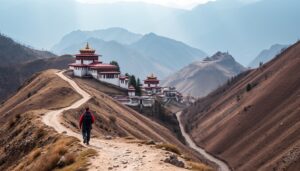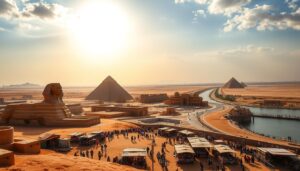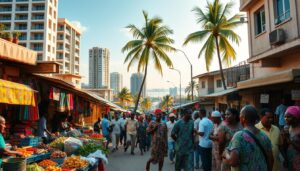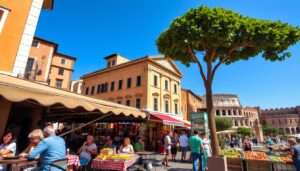Imagine a place with fresh air, untouched landscapes, and a culture steeped in tradition. Bhutan is a country that has kept its heritage alive while welcoming visitors. You’re not just looking for a vacation; you’re searching for an authentic experience that goes beyond the usual tourist spots.
In Bhutan, success is measured by Gross National Happiness, not GDP. This approach shapes tourism, making sure your visit helps local communities and protects the environment. You’re about to start a mindful travel adventure that’s both rewarding and fun.
Key Takeaways
- Discover Bhutan’s unique approach to tourism based on Gross National Happiness.
- Explore authentic Bhutan experiences beyond typical tourist traps.
- Learn how mindful travel can enrich your journey.
- Understand the importance of preserving local culture and environment.
- Experience the pristine landscapes and rich cultural heritage of Bhutan.
The Kingdom of Happiness: Understanding Bhutan's Unique Philosophy
When you arrive in Bhutan, you enter a world shaped by centuries of thought. The country focuses on Gross National Happiness (GNH) over just economic growth. This philosophy values the happiness of its people and the environment.
Gross National Happiness: More Than a Catchphrase
GNH is at the heart of Bhutan’s way of life. It has four main parts: economic growth, cultural values, environmental care, and good governance. This means progress is measured by how happy people are, not just by money.
The Buddhist Foundation of Bhutanese Life
Buddhism deeply influences Bhutan. It shapes the culture, laws, and government policies. Buddhist values like compassion and mindfulness guide the country.
How Bhutan's Philosophy Shapes Your Travel Experience
Traveling wisely in Bhutan lets you dive deep into its culture. You can join local festivals, see ancient temples, and connect with the community. Here’s how you can experience Bhutan’s culture:
| Cultural Aspect | Experience |
|---|---|
| Local Festivals | Participate in Tshechu festivals, witnessing masked dances and traditional rituals. |
| Ancient Temples | Visit historic dzongs and temples, such as Paro Taktsang (Tiger’s Nest Monastery). |
| Community Engagement | Engage with locals through homestays, learning traditional crafts and daily life. |
Planning Your Journey to the Last Himalayan Kingdom
Planning a trip to Bhutan is more than just booking flights and hotels. It’s about understanding the country’s strict tourism rules. Bhutan wants to keep its culture and nature safe, making it a special place to visit.
Navigating Bhutan's Tourism Policy
Bhutan’s tourism policy aims to keep the economy growing while protecting its culture and nature. To do this, the government has set a daily fee for visitors. This fee covers your stay, food, and a guide.
Best Times to Visit for Authentic Experiences
The best times to see Bhutan are in spring (March to May) and autumn (September to November). The weather is nice, and there are many festivals. These seasons are perfect for trekking and exploring.
Required Permits and Documentation
To travel in Bhutan, you need a visa and a permit. Your tour operator will take care of these for you. Just give them your passport details and travel dates early.
Choosing Between Eastern and Western Bhutan
Bhutan has two sides, each with its own charm. Western Bhutan is famous for its old sites and trekking paths. Eastern Bhutan is for those who love untouched landscapes and quiet adventures.
| Region | Highlights | Best Time to Visit |
|---|---|---|
| Western Bhutan | Paro, Thimphu, Punakha | Spring and Autumn |
| Eastern Bhutan | Trashigang, Mongar | Autumn |
Beyond the Daily Tariff: Making Your Bhutan Budget Work
To enjoy Bhutan without spending too much, you must think beyond the daily tariff. This fee covers basics like where you stay, what you eat, and who guides you. But, there are other costs to keep in mind when planning your trip.
Understanding the Minimum Daily Package
The minimum daily package in Bhutan offers a lot. It includes:
- Accommodation in mid-range hotels or lodges
- Meals, with a focus on local cuisine
- A licensed guide to provide insights into Bhutanese culture and history
- Transportation, including fuel and driver
Additional Costs to Consider
There are other expenses to add to your budget:
- Flights to and from Bhutan
- Optional activities or excursions not covered by the daily tariff
- Personal expenses, such as souvenirs or additional meals
Tips for Maximizing Value Without Compromising Authenticity
To make the most of your budget in Bhutan, try these tips:
- Travel during the shoulder season for better rates
- Choose local, family-run accommodations when possible
- Engage in cultural activities and local festivals
Group vs. Private Tours: Financial Implications
Choosing between a group or private tour affects your budget. Group tours are cheaper, but private tours offer more flexibility and a personalized experience.
Finding the Right Guide: Your Gateway to Authentic Bhutan
A local guide in Bhutan is more than a tour leader. They open doors to the country’s true culture and traditions. Traveling with a knowledgeable guide means experiencing the heart of Bhutanese life.
What to Look for in a Local Guide
Choose a guide who speaks English well and knows a lot about Bhutan. They should share insights into local customs and traditions. Make sure your guide is certified by the Tourism Council of Bhutan. This shows they’re trained and understand Bhutan’s tourism rules.
Questions to Ask Before Booking
Before you book, ask about their experience and knowledge of local customs. You might ask, “Can you share some of your favorite experiences or hidden gems in Bhutan?” or “How do you ensure that our tour is respectful of local traditions?”. This helps you understand their expertise and how they’ll make your trip better.
Building Rapport for Deeper Cultural Access
Getting to know your guide can make your cultural experience richer. Be open, respectful, and curious. Show real interest in their culture and way of life. This respect can lead to deeper, more authentic experiences, revealing hidden gems you might not find elsewhere.
How to Request Off-the-Itinerary Experiences
If you want to see more than the usual sights, ask your guide. They can arrange unique experiences like visiting a local farm or attending a community festival. Tell them what you’re interested in, and they’ll try to make it happen.
Experiencing Bhutan: A Journey Beyond Tourist Traps
Your trip to Bhutan can be a deep adventure if you explore off the beaten path. While Bhutan has famous spots, there’s much to see beyond these places.
Moving Past the "Big Five" Attractions
Bhutan’s famous spots like Paro Taktsang and Punakha Dzong are a must-see. But, they’re just the start of your Bhutan journey. Venturing beyond these iconic locations lets you find the country’s true charm.
Seeking Authentic Cultural Exchanges
Meeting local communities can lead to deep cultural exchanges. You can join in traditional festivals, visit homes, or participate in community activities. As one traveler said,
“The warmth of the Bhutanese people is something that stays with you long after you’ve left their country.”
Balancing Must-See Sights with Hidden Gems
A good plan should mix famous spots with hidden gems. This mix lets you see all of Bhutan’s culture and beauty. Think about visiting rural villages or hiking in the Himalayas.
Creating Space for Spontaneous Discoveries
Planning is key, but so is leaving room for surprises. Some of the best moments come from unexpected meetings or detours. As you travel wisely, these moments often become the trip’s highlights.
By embracing the unknown and being open to new things, you’ll truly experience Bhutan beyond the usual tourist spots.
Rural Bhutan: Where Authenticity Thrives
Exploring rural Bhutan, you find a world rich in tradition and authenticity. It’s a place where Bhutanese culture shines, away from the tourist rush.
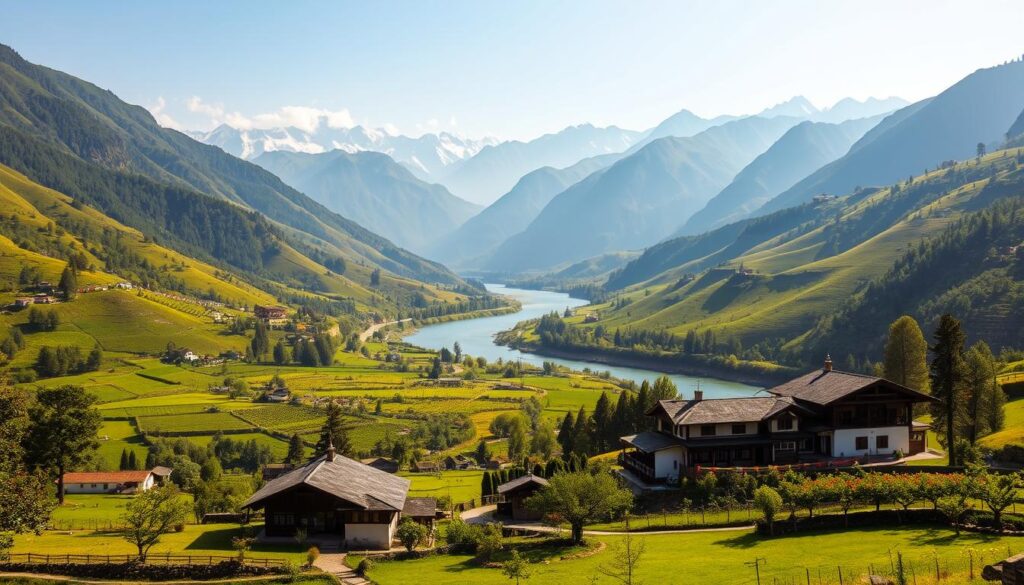
Village Homestays and Farm Experiences
Living in village homestays and farms is a deep dive into rural Bhutan. You get to stay with local families, help with daily tasks, and learn about traditional farming. This cultural immersion in Bhutan lets you truly understand the local lifestyle.
Participating in Agricultural Activities
Try your hand at rice planting, harvesting, and threshing. These activities give you a real feel for Bhutanese farming. Plus, they help you connect with the local community.
Connecting with Traditional Lifestyles
Rural Bhutan is a living museum of old ways of life. By staying in villages, you see the daily life, festivals, and crafts that have lasted for generations. This authentic Bhutan exploration makes your trip unforgettable.
Lesser-Known Villages Worth Visiting
While Paro and Thimphu are famous, many hidden villages are waiting to be discovered. Places like Merak and Sakteng offer unique cultural experiences and stunning views. They’re perfect for those looking for a unique adventure in rural Bhutan.
Visiting these rural areas helps the local economy and keeps Bhutan’s culture alive. Your trip to rural Bhutan will be filled with real experiences and a newfound love for this Himalayan kingdom.
Sacred Experiences: Respectful Participation in Spiritual Bhutan
In Bhutan, the lines between the sacred and everyday life are thin. This gives travelers a special chance to connect with the country’s spiritual heart. As you wander through this Himalayan kingdom, you’ll find many ways to join in sacred experiences. These moments will help you understand Bhutanese culture more deeply.
Temple Etiquette and Participation Guidelines
When you visit temples, it’s key to follow local customs. This means taking off your shoes before entering, walking around stupas and altars in a clockwise direction, and treating religious items with care. By doing this, you show respect and make your visit more meaningful.
Attending Local Festivals Beyond Paro Tshechu
Bhutan is known for its lively festivals, or tshechus. While Paro Tshechu is famous, Thimphu Tshechu and Punakha Tshechu are just as rewarding. These festivals open a window into Bhutan’s rich culture and spirituality.
Meditation and Mindfulness Opportunities
Bhutan has many meditation and mindfulness retreats. These are led by local monks. They offer a peaceful place to practice mindfulness and connect with the spiritual community.
Connecting with Local Monks and Practitioners
Talking with local monks and practitioners is a deeply enriching experience. Many monasteries welcome visitors. They give a peek into the daily lives of these spiritual leaders.
| Experience | Location | Best Time |
|---|---|---|
| Temple Visit | Punakha Dzong | Early Morning |
| Festival Attendance | Thimphu Tshechu | September/October |
| Meditation Retreat | Gangtey Monastery | October/November |
Culinary Adventures: Tasting the Real Bhutan
Your journey through Bhutan’s flavors starts with trying its unique tastes. Bhutanese food is special, shaped by its culture and location. It offers a mix of flavors that show the country’s traditions and lifestyle.
Beyond Ema Datshi: Regional Specialties
Ema Datshi is Bhutan’s famous dish, but there’s more to try. You can enjoy Hoentoe, a buckwheat noodle dish from the east. Or, try Red Rice, a local favorite with a nutty taste and health perks.
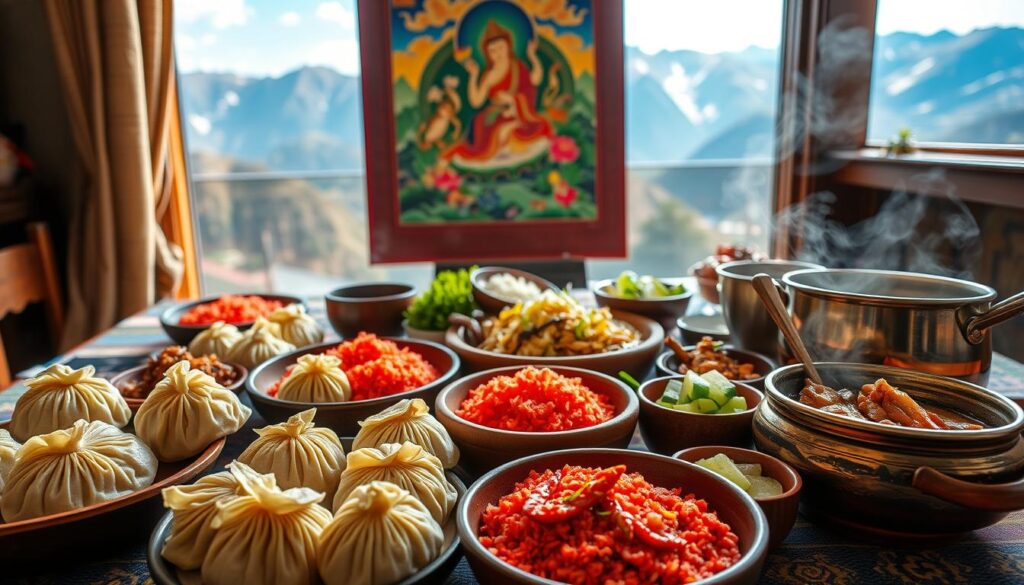
Finding Authentic Local Eateries
For real Bhutanese flavors, go beyond tourist spots to local places. These spots offer a true taste of Bhutan. You can try traditional dishes in a local setting.
Participating in Food Preparation
Get closer to Bhutan’s culture by helping with food. Many tours and homestays have cooking classes. Here, you can learn to make traditional dishes and understand their unique ingredients and methods.
Bhutanese Tea Culture and Social Customs
Bhutan’s tea culture is key to its social life. Suja (butter tea) is a daily favorite. Joining tea ceremonies or sharing tea with locals gives you a peek into Bhutan’s social norms and hospitality.
| Regional Specialty | Description |
|---|---|
| Ema Datshi | Chili and cheese stew, Bhutan’s national dish |
| Hoentoe | Buckwheat noodles, a specialty from eastern Bhutan |
| Red Rice | A staple in Bhutan, known for its nutty flavor |
Exploring Bhutan’s food scene reveals stories of its rich culture and people’s bond with the land.
Trekking Off the Beaten Path: Wilderness Experiences
Bhutan’s wilderness calls to those seeking adventure and peace. It offers trekking paths that go beyond usual tourist routes. These paths promise a genuine Bhutan experience.
Lesser-Known Trails with Cultural Significance
Bhutan has trails rich in culture that few know about. The Druk Path Trek is a prime example. It links Paro and Thimphu valleys, passing historic sites and showing off the Himalayas.
Community-Based Trekking Options
Community-based trekking is growing in Bhutan. It lets trekkers meet locals and support sustainable tourism. The Snowman Trek is a standout, lasting over 30 days. It goes through remote villages and high-altitude lakes, giving a unique adventure and helping the local economy.
Responsible Wilderness Practices
As trekking in Bhutan grows, it’s key to protect the environment. Trekkers should follow Leave No Trace principles. This means leaving the natural world untouched and respecting local traditions.
Seasonal Considerations for Remote Treks
The best trekking times in Bhutan vary by region and altitude. Spring (March to May) and autumn (September to November) are usually best. But, some treks can be busier and harder during these times, so plan carefully.
| Trek Name | Duration | Difficulty Level | Highlights |
|---|---|---|---|
| Druk Path Trek | 4-5 days | Moderate | Historic sites, Himalayan views |
| Snowman Trek | 30 days | Challenging | Remote villages, high-altitude lakes |
| Jhomolhari Trek | 7-9 days | Moderate to Challenging | Jhomolhari peak views, alpine lakes |
Ethical Photography and Cultural Respect: Being a Mindful Visitor
Exploring Bhutan’s stunning landscapes and rich culture requires mindfulness. Being respectful and considerate, including in photography, greatly enhances your visit. It also improves the experience of the locals.
Photography Guidelines for Sacred Sites
At sacred sites, knowing and following local photography rules is key. Some places may not allow cameras, while others might need a respectful distance or permission. Always watch what locals do and follow their example.
Approaching Locals for Portraits
Getting permission to take someone’s portrait is a sign of respect. A smile and a kind word can make your interaction special. Consider giving a small gift or a print of the photo as a thank you.
Digital Minimalism for Maximum Presence
Practicing digital minimalism helps you stay present. By focusing less on taking pictures, you can connect more with your surroundings and the people you meet.
Gift-Giving and Social Exchanges
In Bhutan, gift-giving is a big part of culture. When you’re part of social exchanges, bring small, meaningful gifts. These should reflect your culture or be useful to the locals. It’s a way to build genuine connections and show respect for their customs.
Conclusion: Carrying Bhutan's Wisdom Home
As you finish your trip to Bhutan, you’re not just leaving a place. You’re taking with you the heart of a culture that cherishes happiness and mindfulness. To travel wisely in Bhutan means to embrace its special philosophy and ways. This lets you experience Bhutan in a deeper way, beyond just seeing sights.
A prudent traveller dives into local customs and traditions. This way, you’ve probably learned to value the simple things more. You’ve also seen things from a new perspective, understanding what true happiness is.
When you get back home, use the bhutan travel tips you picked up. Let Bhutan’s peace and beauty inspire you to live more mindfully. See the beauty around you with new eyes.
Experiencing Bhutan: a journey beyond tourist traps is more than visiting a new spot. It’s about changing how you see the world. Carry this wisdom with you, and let it lead you to a more rewarding life.
FAQ
What is Gross National Happiness and how does it influence tourism in Bhutan?
Gross National Happiness is a unique philosophy in Bhutan. It guides the country’s development, including tourism. It focuses on sustainable and culturally sensitive tourism. This ensures visitors have real experiences while keeping the culture and environment intact.
What are the best times to visit Bhutan for authentic experiences?
The best times to visit Bhutan are spring (March to May) and autumn (September to November). The weather is mild, and festivals are held. This gives visitors a glimpse into Bhutanese culture.
What permits and documentation are required for traveling in Bhutan?
Visitors need a visa, arranged through a licensed tour operator. They must also pay a daily tariff for accommodation, meals, and guided tours. Additional permits might be needed for trekking or visiting certain areas.
How can I maximize value without compromising the authenticity of my Bhutan experience?
To get the most value, travel during the shoulder season. Opt for group tours and choose local guides. Being flexible with your itinerary can also help.
What should I look for in a local guide for an authentic Bhutan experience?
Look for guides who know a lot about Bhutanese culture, history, and customs. They should speak your language well. They should offer insights beyond what you usually hear.
How can I participate in agricultural activities or village homestays in rural Bhutan?
Many tour operators offer homestay and farm experience programs. You can also join community-based tourism initiatives. These allow you to take part in local agricultural activities.
What are some lesser-known villages worth visiting in Bhutan?
Visit Merak and Sakteng in eastern Bhutan, and Gangtey in central Bhutan. These places offer authentic experiences and insights into traditional Bhutanese lifestyles.
How can I respectfully participate in spiritual experiences in Bhutan?
When visiting temples or attending festivals, dress modestly and follow local etiquette. Be respectful of monks and practitioners. You can also try meditation and mindfulness practices at local centers.
What are some regional specialties I should try beyond Ema Datshi?
Try Hoentoe (a pasta dish) in the east, and red rice grown in certain regions. Be adventurous and eat local dishes at authentic eateries.
What are some responsible wilderness practices I should follow while trekking in Bhutan?
Follow “Leave No Trace” principles, stay on trails, and respect local regulations and wildlife. Hire local guides and porters to support the local economy.
What are the guidelines for photography at sacred sites in Bhutan?
Be respectful and don’t take pictures inside temples or of sacred objects without permission. Always ask before taking portraits of locals. Be mindful of your surroundings.
How can I practice digital minimalism during my trip to Bhutan?
Limit your use of digital devices and be present in the moment. Take time to observe your surroundings, engage with locals, and enjoy Bhutan’s natural beauty.


